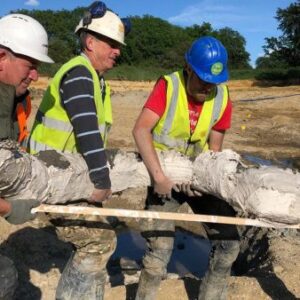Mystery behind Cleopatra’s tomb: Two mummies discovered in Egypt could help solve it
The discovery of two high-status ancient Egyptian mummies in a temple on the Nile delta has rekindled hopes of locating the final resting place of Cleopatra, the legendary Egyptian queen.
Found in a tomb undisturbed for 2,000 years, the mummies have suffered deterioration due to water seepage, as reported by The Guardian. Originally adorned with gold leaf—a luxury reserved for the societal elite—suggests a potential connection with Cleopatra herself.
Believed to be a male and a female, these mummies may have served as priests crucial to upholding the influence of the legendary Egyptian queen and her lover, Mark Antony.
Within the same site, 200 coins featuring Cleopatra’s name and likeness were unearthed, believed to have been minted under her direct instructions. The elusive tomb of Mark Antony and Cleopatra VII from 30 BC is still undiscovered, likely situated near Alexandria in Egypt.
The research team is confident that ongoing excavations at Taposiris Magna, an ancient city marked by a standing temple, will soon unveil the resting place of this ancient couple. Despite excavation efforts since 2005, only a fraction of the expansive site has been explored.
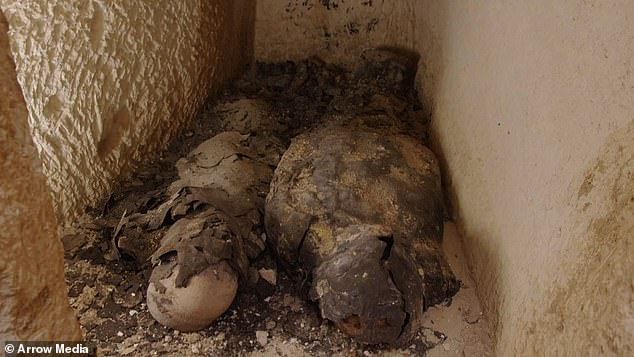
The two mummies found inside a sealed tomb at Taposiris Magna, where digs are ungoing to oncover the grave of Cleopatra

The temple is located near Alexandria, the capital of ancient Egypt and where Cleopatra killed herself in 30 BC
The discovery of the mummies took place within the first-ever intact tomb opened at Taposiris Magna, a significant event documented in an upcoming Channel 5 broadcast.
Dr. Glenn Godenho, a senior lecturer in Egyptology at Liverpool University, remarked to The Guardian that despite being now covered in 2,000 years’ worth of dust, these mummies would have been impressive in their time. The presence of gold leaf indicates their importance in society.
One of the mummies was found adorned with a scarab image in gold leaf, symbolizing rebirth. The 200 coins featuring Cleopatra’s likeness directly link the pharaoh to Taposiris Magna, established in the third century BC.
Contrary to the glamorous depictions of Cleopatra in film, the coins reveal a more distinctive portrayal, with a “prominent nose and double chin.” Dr. Godenho suggests that the anticipated tomb of Antony and Cleopatra would be more grandiose than that of the mummified couple discovered.
While the appearance of Ptolemaic rulers’ tombs remains unknown, Dr. Godenho expresses skepticism that they would be indistinguishable from common burials. He also notes that the evidence points away from these mummies being of royal status, as the presumed location of Cleopatra and Mark Antony’s tomb is typically associated with Alexandria, not Taposiris Magna.
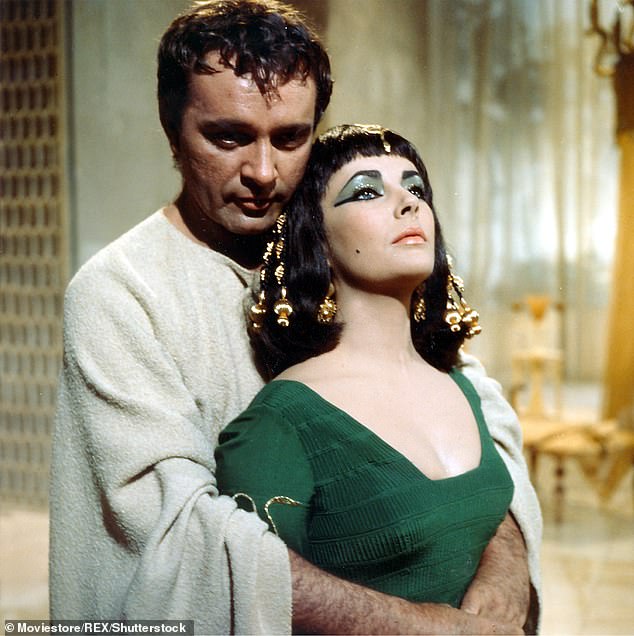
Archaeologists searching for the tomb of Anthony and Cleopatra (pictured played by Richard Burton and Elizabeth Taylor in the 1963 film) have zeroed in on a site in northern Egypt
Dr. Kathleen Martinez, an academic hailing from the Dominican Republic, is at the forefront of the excavation efforts at the Taposiris Magna temple. With over 14 years of dedicated work, Dr. Martinez and her colleagues are increasingly confident that Cleopatra’s tomb will be unearthed at this site.
In the upcoming Channel 5 documentary airing on Thursday, viewers can witness Dr. Martinez’s reaction to the unveiling of the newly-discovered mummies at Taposiris Magna. As an initial limestone slab is removed, her astonishment is captured on film as she exclaims, “Oh my god, there are two mummies… See this wonder.”
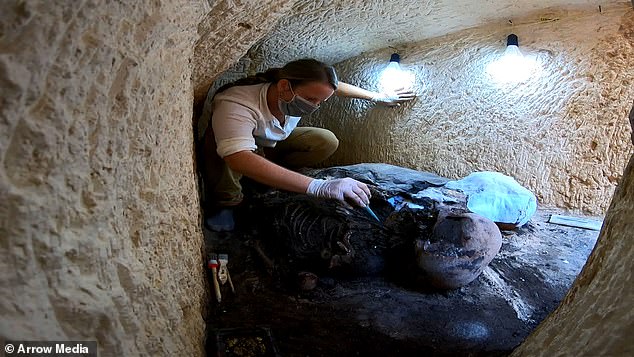
Osteoarchaeologist, Dr Linda Chapon, working to conserve the two mummies found inside a sealed tomb at Taposiris Magna
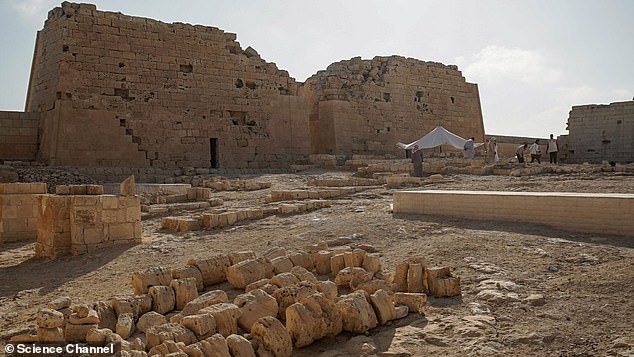
Experts believe Cleopatra made plans for herself and Anthony to be buried at a temple called Taposiris Magna in order to imitate the ancient myth of Isis and Osiris
Cleopatra, Egypt’s last pharaoh, ruled the Ptolemaic Kingdom of Egypt from 51 BC to 30 BC. Dr. Martinez believes that Cleopatra and her Roman lover Mark Antony may have been interred at the Taposiris Magna site 2,000 years ago due to Cleopatra’s desire to emulate an ancient prophecy.
Throughout her life (69 BC to 30 BC), Cleopatra was renowned as both a seductress and a captivating personality. She strategically used her charms to first captivate Julius Caesar, solidifying Egypt’s alliance with Rome, and later to enchant his successor, Mark Antony.
In an effort to establish herself and Antony as prominent rulers in the eyes of the Egyptian people, Cleopatra also worked diligently to associate them with the myth of Isis and Osiris. According to the myth, Osiris was slain and dismembered, with his pieces scattered across Egypt. After locating and reassembling all the pieces, Isis managed to resurrect her husband for a limited period.
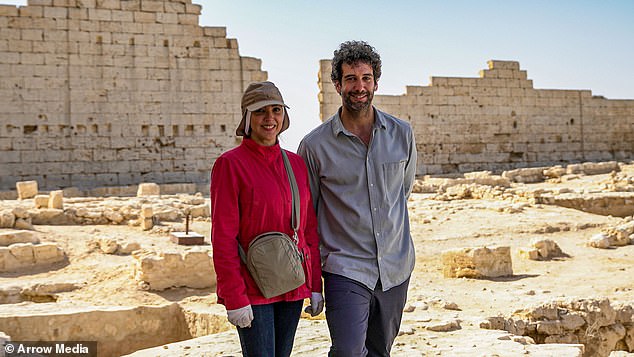
Dr Glenn Godenho and Dr Kathleen Martinez inside Taposiris Magna temple near Alexandria in Egypt

Kathleen Martinez, who is leading the dig, believes the site was strongly associated with the myth of Isis and Osiris – a myth that Cleopatra often tried to imitate during her life
Martinez contends that Taposiris Magna holds a close connection to the myth, as its name translates to the ‘tomb of Osiris.’
The presence of ‘Osiris’ in the name suggests that it might be one of the locations where Osiris’s body was scattered in the myth. In the aftermath of Mark Antony’s suicide following his defeat to Octavian, and before her own demise, Cleopatra is believed to have meticulously arranged for both of them to be buried at Taposiris Magna, echoing elements of the myth, according to Dr. Martinez’s theory.

The temple at Taposiris Magna. The opening of the first-ever intact tomb found at Taposiris Magna will be shown on Channel 5 this week
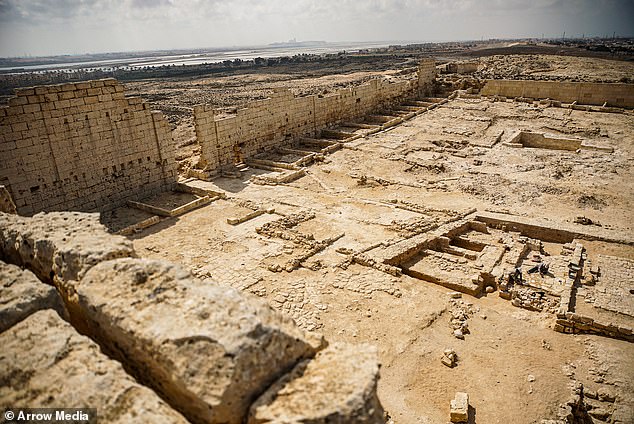
The inside of Taposiris Magna temple, where excavation work is taking place. The temple was established between 280 and 270 BC
As per Dr. Martinez’s account to National Geographic, Cleopatra negotiated with Octavian to have Mark Antony buried in Egypt, expressing her desire to be interred alongside him to reenact the legend of Isis and Osiris. The underlying significance of the Osiris cult lies in the bestowal of immortality, with the belief that, in death, the gods would permit Cleopatra to exist eternally with Antony in another form.
Nevertheless, skepticism surrounds this theory, as some experts posit that Cleopatra was hastily buried in Alexandria itself—the city from which she governed Egypt until her death, attributed to snake venom.

